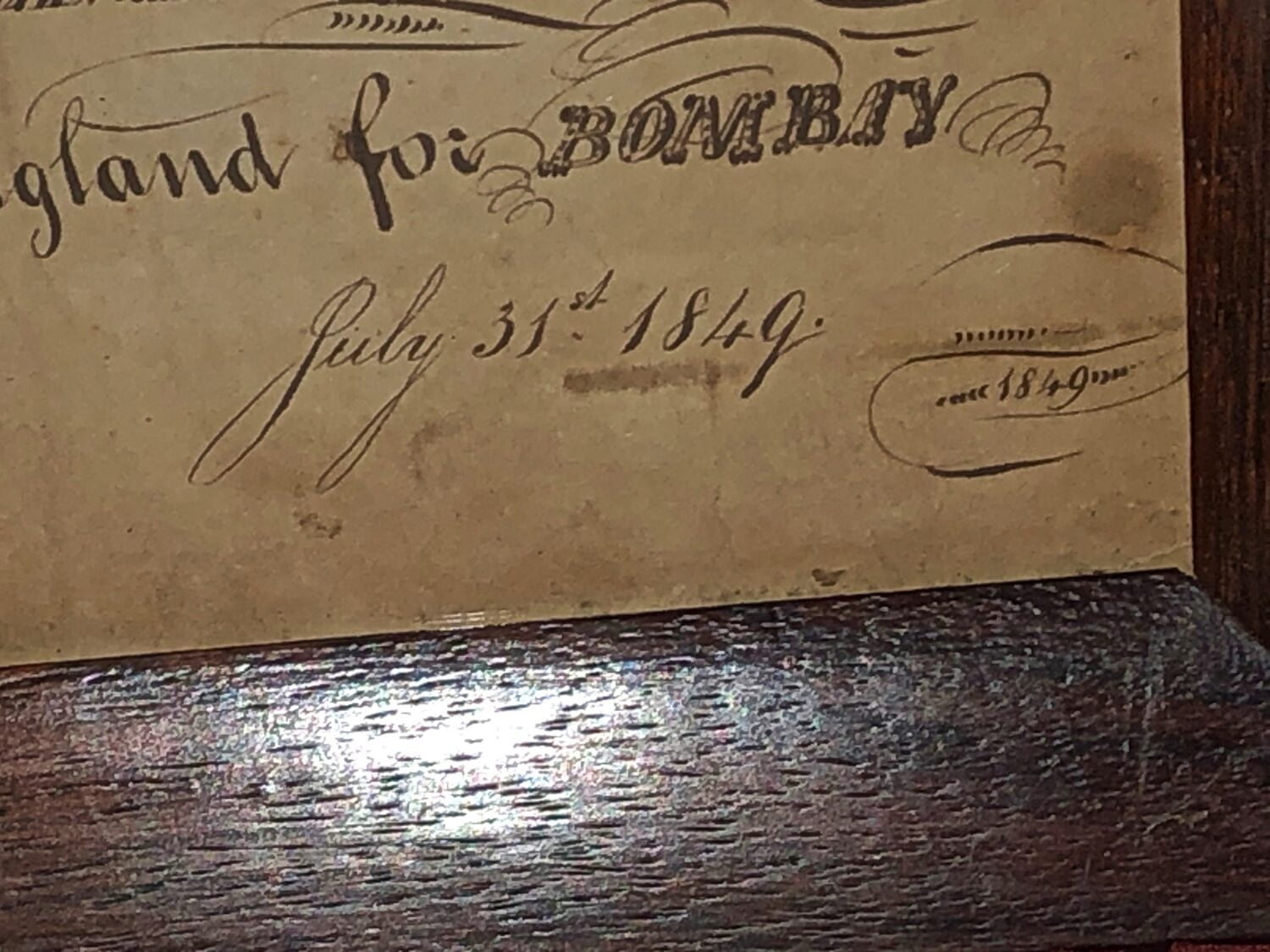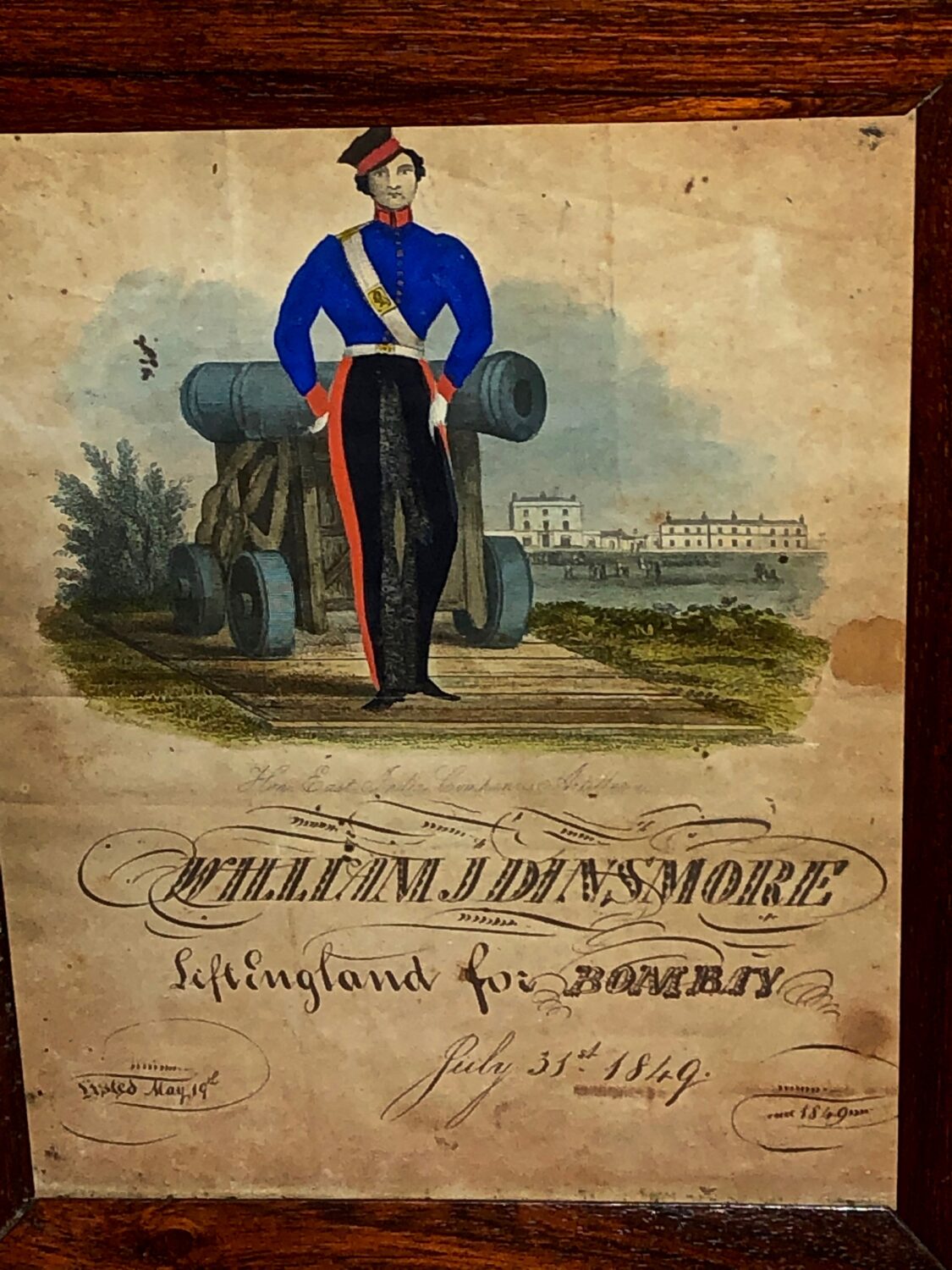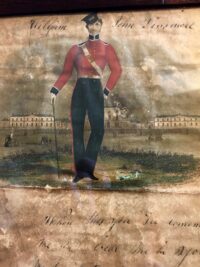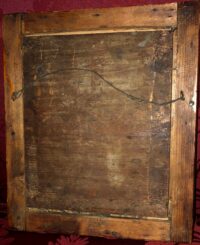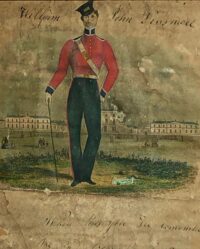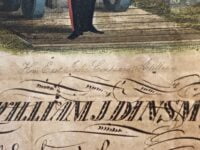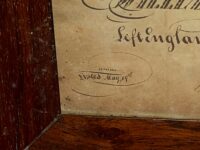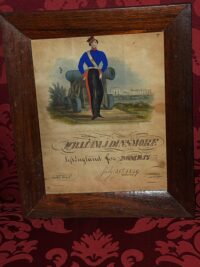1840s Watercolor Portraits of A Soldier in an East India Company Military Unit
$575
1840s Watercolor Portraits of A Soldier in an East India Company Military Unit – These two rare watercolor paintings depict the same, uniformed, privately paid, British soldier – William John Dinsmore. The East India Company, also called English East India Company, formally (1600–1708) Governor and Company of Merchants of London Trading into the East Indies or (1708–1873) United Company of Merchants of England Trading to the East Indies, English company formed for the exploitation of trade with East and Southeast Asia and India, incorporated by royal charter on December 31, 1600. Starting as a monopolistic trading body, the company became involved in politics and acted as an agent of British imperialism in India from the early 18th century to the mid-19th century. In addition, the activities of the company in China in the 19th century served as a catalyst for the expansion of British influence there.*
The East India Company maintained its own, mercenary military force, and Dinsmore apparently “enlisted” in May of 1849 and left for Bombay on or around July 31 of the same year. These two rare watercolors appear to each have been painted on a chromolithograph, seemingly provided to India-bound mercenaries, to leave behind or send, as solace, to their families or loved ones. The calligraphically executed lettering on each, was hand inked, describing the name, date and destination for the “soldier” depicted, as well as his enlistment and departure dates. Beneath the painting of Dinsmore, on both of the papers, is a descriptor – “East India Company Artillery” (beneath Dinsmore in a blue tunic) and “East India Company Infantry” (beneath Dinsmore in a red tunic). Beneath the painting of Dinsmore, outfitted in a red tunic, with his name inked beside his head, is a poignant inscription, apparently for the young lady, Dinsmore is leaving behind as he sojourned to far away India. Dinsmore’s inscription reads as follows:
“When this you see remember
me and bear me in you
mind For I still think on
the girl I left behind
Private William John
Dinsmore”
The watercolors are in overall good condition, each exhibiting some minor tears and small holes, as well as some age staining; both display extremely well, with the colors remaining vivid and the writing easily read. Each painting is housed in its original, rosewood veneer frames, with its original glass. These are quite unique; we have never encountered paintings with this provenance before. Price is for the pair.
The paintings both measure as follows: Frame: Height – 11”; Width – 9.5”; Sight: Height – 8.5”; Width – 6.75”.
*Online – The Encyclopedia Britannica
East India Company
| East India Company | |
| Former type | Public |
| Industry | International trade, Opium trafficking |
| Fate | Government of India Act 1858 |
| Founded | 31 December 1600 |
| Founders | John Watts, George White |
| Defunct | 1 June 1874 |
| Headquarters | London
, |
| Products | Cotton, silk, indigo dye, salt, spices, saltpetre, tea, and opium |
| Colonial India | |
| Dutch India | 1605–1825 |
| Danish India | 1620–1869 |
| French India | 1668–1954 |
| Portuguese India (1505–1961) |
|
| Casa da Índia | 1434–1833 |
| Portuguese East India Company | 1628–1633 |
| British India (1612–1947) |
|
| East India Company | 1612–1757 |
| Company rule in India | 1757–1858 |
| British Raj | 1858–1947 |
| British rule in Burma | 1824–1948 |
| Princely states | 1721–1949 |
| Partition of India | 1947 |
The East India Company (EIC), also known as the Honourable East India Company (HEIC), East India Trading Company (EITC), the English East India Company or the British East India Company, and informally known as John Company, Company Bahadur, or simply The Company, was an English and later British joint-stock company. It was formed to trade in the Indian Ocean region, initially with the Moghuls of India and the East Indies, and later with Qing China. The company ended up seizing control of large parts of the Indian subcontinent (and briefly Afghanistan), colonised parts of Southeast Asia, and colonised Hong Kong after the First Opium War.
Originally chartered as the “Governor and Company of Merchants of London Trading into the East-Indies”, the company rose to account for half of the world’s trade, particularly in basic commodities including cotton, silk, indigo dye, salt, spices, saltpetre, tea, and opium. The company also ruled the beginnings of the British Empire in India. In his speech to the House of Commons in July 1833, Lord Macaulay explained that since the beginning, the East India Company had always been involved in both trade and politics, just as its French and Dutch counterparts had been.[
The company received a Royal Charter from Queen Elizabeth I on 31 December 1600, coming relatively late to trade in the Indies. Before them the Portuguese Estado da Índia had traded there for much of the 16th century and the first of half a dozen Dutch Companies sailed to trade there from 1595. These Dutch companies amalgamated in March 1602 into the Dutch East India Company (VOC), which introduced the first permanent joint stock from 1612 (meaning investment into shares did not need to be returned, but could be traded on a stock exchange). By contrast, wealthy merchants and aristocrats owned the EIC’s shares. Initially the government owned no shares and had only indirect control until 1657 when permanent joint stock was established.[
During its first century of operation, the focus of the company was trade, not the building of an empire in India. Following the First Anglo-Mughal War, the company interests turned from trade to territory during the 18th century as the Mughal Empire declined in power and the East India Company struggled with its French counterpart, the French East India Company (Compagnie française des Indes orientales) during the Carnatic Wars of the 1740s and 1750s. The battles of Plassey and Buxar, in which the company defeated the Nawabs of Bengal, left the company in control of the proto-industrialised Mughal Bengal with the right to collect revenue, in Bengal and Bihar,[13] and a major military and political power in India. In the following decades it gradually increased the extent of the territories under its control, controlling the majority of the Indian subcontinent either directly or indirectly via local puppet rulers under the threat of force by its Presidency armies, much of which were composed of native Indian sepoys.
By 1803, at the height of its rule in India, the East India company had a private army of about 260,000—twice the size of the British Army, with Indian revenues of £13,464,561 (equivalent to £229.9 million in 2019) and expenses of £14,017,473 (equivalent to £239.3 million in 2019). The company eventually came to rule large areas of India with its private armies, exercising military power and seizing administrative functions. Company rule in India effectively began in 1757 and lasted until 1858, when, following the Indian Rebellion of 1857, the Government of India Act 1858 led to the British Crown‘s assuming direct control of the Indian subcontinent in the form of the new British Raj.
The company’s army played a notorious role in the unsuccessful Indian Uprising (also called the Indian Mutiny) of 1857–58, in which Indian soldiers in the company’s employ led an armed revolt against their British officers that quickly gained popular support as a war for Indian independence. During more than a year of fighting, both sides committed atrocities, including massacres of civilians, though the company’s reprisals ultimately far outweighed the violence of the rebels. The rebellion brought about the effective abolishment of the East India Company in 1858.[1
Despite frequent government intervention, the company had recurring problems with its finances. It was dissolved in 1874 as a result of the East India Stock Dividend Redemption Act passed one year earlier, as the Government of India Act had by then rendered it vestigial, powerless, and obsolete. The official government machinery of British India assumed the East India Company’s governmental functions and absorbed its navy and its armies in 1858.















